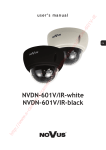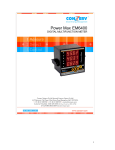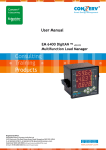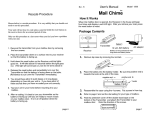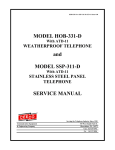Download Installation and user manual for 601V & 601VK - aes
Transcript
Installation and user manual for 601V & 601VK intercom systems 1. 2. 3. 4. Please read all instructions before proceeding to install this system. This wireless intercom uses radio frequency signals to communicate. Its maximum range in an open field without obstacles can be up to 300 meters, however, with interference and obstacles, this can be reduced to 40-70 meters working range. Please power up the unit in its desired location and TEST functionality BEFORE installing the system. If it does not work at your required range, then you can return the unit in NEW condition, thus reducing restocking fees which may apply. Wire as per wiring diagram below.. Notes 1. 2. 3. 4. 5. The transmitter should be mounted high up, in a location so as to achieve line of sight to the property. This will help increase range. The transmitter enclosure is weatherproof. Do not install in a metal enclosure. Ensure that when fitting the antenna, that the rubber seal is used. Carefully observe polarity for the microphone. The solid red wire on the mic is positive, and the red and black wire is negative or ground. Once the system is operational, you can adjust the speaker volume with the volume control knob. Do not adjust too high as this will cause faulty operation. Note SW1. This will adjust the relay output time to either 1.5 seconds or 5 seconds. Keypad Programming Press ENTER Enter Engineers code First time factory preset 111111 Confirm or change engineers code Press ENTER Press ENTER Press ENTER Press ENTER Press ENTER Press ENTER Press ENTER Enter access code relay 1 4-8 digits Enter access time relay 1 2 digits, (01-99). E.g. 03 = 3 seconds Enter access code relay 2 Enter access time relay 2 Enter access code relay 3 Enter access time relay 3 System ready to use Red LED will be OFF Installation and user manual for 601V & 601VK intercom systems 1. 2. 3. 4. Install the batteries in the internal handset. You may need to charge them for a few hours before testing. It is recommended that in order to achieve maximum battery life, that the batteries get a full 8-12 hour charge at the beginning. Batteries can last several hours between charging. Once the system is fully wired up, test the working range before mounting hardware. Press the call button on the out door station. The out door station will chime and the indoor handset should ring (ensure antenna is extended for best results). You can answer the call by pressing the answer button as shown. Test the gate release function, by pressing and holding the open button for 3 seconds. Please note: Your handset and transmitter have been calibrated to communicate with each other. In the event that they do not communicate properly even at close range, you may need to re-register the units together. This will also need done if you are replacing a handset, or adding a second handset to the system. Handset coding… 1) 2) 3) 4) 5) Press and hold the transfer button on a handset. After 3 seconds, one of the 4 lights on the handset will remain permanently lit. This indicates that the handset has entered into coding mode. Release the transfer button, and press it again to cycle through the channels. Each LED will light up in turn indicating channels 1 through to 4. Repeat this for any other handsets, ensuring that all handsets are set to different codes. When all handsets have been set into coding mode, press and hold the coding button on the out door transmitter, until an alert tone is heard. When the alert tone stops, and the handsets LEDs begin to flash again, this indicates successful coding completed. Trouble shooting Noise or reception problems – Ensure that the base station is not installed near metal objects or reinforced walls. Ensure that the handset antenna is fully extended, and that the battery is fully charged. Unit will not work – Check the out door station power LED is on. Check the handset battery is flashing. Double check all wiring. Test the system at close range. Try re-registering the units as per procedure above.



